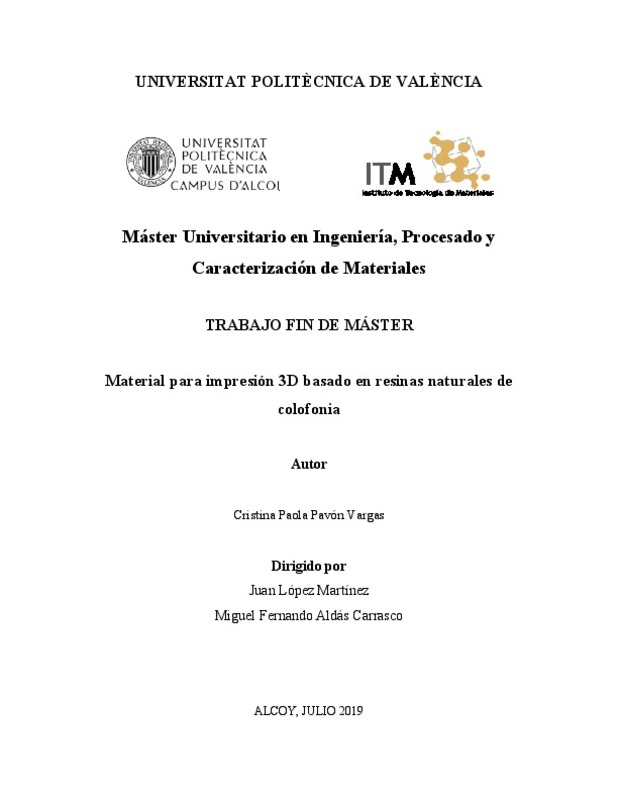|
Resumen:
|
[ES] En el presente trabajo de fin de máster se prepararon mezclas de Policaprolactona (PCL) con
colofonia (GR) y cera de abeja (BW), que se utilizaron para la preparación de filamentos para
ser empleados en procesos de ...[+]
[ES] En el presente trabajo de fin de máster se prepararon mezclas de Policaprolactona (PCL) con
colofonia (GR) y cera de abeja (BW), que se utilizaron para la preparación de filamentos para
ser empleados en procesos de impresión 3D. Además, con el fin de caracterizar los materiales
y determinar el efecto de la adición de GR, BW o la mezcla de ambos (GR_BW) sobre las
propiedades de la PCL se imprimieron probetas de ensayos mecánicos y se realizaron análisis
térmicos, mecánicos, estructurales, de humectabilidad y color. En el proceso de impresión
3D se escogió el patrón de llenado de los objetos a imprimir y establecieron las temperaturas
de cama y de extrusión para cada material, se determinó que el material PCL_GR_BW
presenta un mejor comportamiento en la impresión 3D. La caracterización térmica de las
probetas permitió determinar que los aditivos empleados son miscibles y compatibles con la
PCL, mientras que con la caracterización mecánica se estableció que la adición de GR_BW
le proporciona una mayor resistencia a la tracción al filamento de modo que facilita la
impresión en 3D. Por el contrario, la adición de BW le confiere demasiada ductilidad a la
mezcla lo que dificulta su procesamiento. En el FTIR se puede inferir una interacción entre
la PCL y los aditivos usados. Se encontró que los aditivos naturales empleados actuaron como
plastificantes, pero se estableció que aquellos materiales en los que se usó GR presentaron
una menor plastificación, debido a la rigidez propia de este aditivo, lo que confirió mejores
propiedades mecánicas al material.
[-]
[EN] In the present work, mixtures of Polycaprolactone (PCL) were prepared with gum rosin (GR)
and beeswax (BW), which were used to prepare filaments for 3D printing processes. In
addition, to characterize the materials ...[+]
[EN] In the present work, mixtures of Polycaprolactone (PCL) were prepared with gum rosin (GR)
and beeswax (BW), which were used to prepare filaments for 3D printing processes. In
addition, to characterize the materials and determine the effect of the addition of GR, BW or
the mixture of both (GR_BW) on the properties of the PCL, mechanical test specimens were
printed and thermal, mechanical, structural, wettability and color analyzes were carried out.
In the 3D printing process, the filling pattern of the objects to be printed was chosen and the
bed and extrusion temperatures for each material were established. It was determined that the
material PCL_GR_BW has a better behavior in 3D printing. The thermal characterization of
the specimens allowed to determine that the additives used are miscible and compatible with
the PCL, while with the mechanical characterization it was established that the addition of
GR_BW provides a greater tensile strength to the filament which facilitates the processing in
a 3D printer. On the contrary, the addition of BW gives the mixture too much ductility, which
makes its processing difficult. In the FTIR, an interaction between the PCL and the additives
used was detected. It was found that the natural additives used acted as plasticizers. However,
those materials in which GR was used had a lower plasticization, due to the inherent rigidity
of this additive, which confer better mechanical properties to the material.
[-]
|







